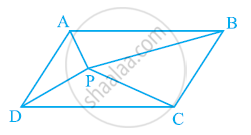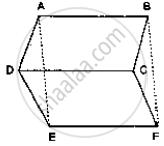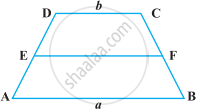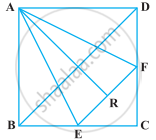Advertisements
Advertisements
प्रश्न
In the below fig. ABCD and AEFD are two parallelograms. Prove that
(1) PE = FQ
(2) ar (Δ APE) : ar (ΔPFA) = ar Δ(QFD) : ar (Δ PFD)
(3) ar (ΔPEA) = ar (ΔQFD)
उत्तर
Given that, ABCD and AEFD are two parallelograms
To prove: (1) PE = FQ
(2) `"ar (ΔAPE)"/ "ar (ΔPFA)"` = `"ar (ΔQFD)"/"ar (ΔPED)"`
(3) ar (ΔPEA) = ar (ΔQFD)
Proof: (1) In ΔEPA and ΔFQD
∠PEA = ∠QFD [ ∴ Corresponding angles]
∠EPA = ∠FQD [Corresponding angles]
PA = QD [opp .sides of 11gm]
Then, ΔEPA ≅ ΔFQD [By. AAS condition]
∴ EP = FQ [c. p. c.t]
(2) Since, ΔPEA and ΔQFD stand on the same base PEand FQlie between the same
parallels EQ and AD
∴ ar (ΔPEA ) = ar (ΔQFD) → (1)
AD ∴ ar (ΔPFA) = ar (PFD) .....(2)
Divide the equation (1) by equation (2)
`"area of (ΔPEA)"/"area of (ΔPFA)"` = `"ar Δ(QFD)"/"ar Δ(PFD)"`
(3) From (1) part ΔEPA ≅ FQD
Then, ar (ΔEDA) = ar (ΔFQD)
APPEARS IN
संबंधित प्रश्न
A farmer was having a field in the form of a parallelogram PQRS. She took any point A on RS and joined it to points P and Q. In how many parts the field is divided? What are the shapes of these parts? The farmer wants to sow wheat and pulses in equal portions of the field separately. How should she do it?
In the given figure, P is a point in the interior of a parallelogram ABCD. Show that
(i) ar (APB) + ar (PCD) = 1/2ar (ABCD)
(ii) ar (APD) + ar (PBC) = ar (APB) + ar (PCD)
[Hint: Through. P, draw a line parallel to AB]

Parallelogram ABCD and rectangle ABEF are on the same base AB and have equal areas. Show that the perimeter of the parallelogram is greater than that of the rectangle.
In the following figure, ABCD is parallelogram and BC is produced to a point Q such that AD = CQ. If AQ intersect DC at P, show that
ar (BPC) = ar (DPQ).
[Hint: Join AC.]

In the given below fig. ABCD, ABFE and CDEF are parallelograms. Prove that ar (ΔADE)
= ar (ΔBCF)

In which of the following figures, you find two polygons on the same base and between the same parallels?
Two parallelograms are on equal bases and between the same parallels. The ratio of their areas is ______.
ABCD is a trapezium with parallel sides AB = a cm and DC = b cm (Figure). E and F are the mid-points of the non-parallel sides. The ratio of ar (ABFE) and ar (EFCD) is ______.

ABCD is a square. E and F are respectively the mid-points of BC and CD. If R is the mid-point of EF (Figure), prove that ar (AER) = ar (AFR)

ABCD is a trapezium in which AB || DC, DC = 30 cm and AB = 50 cm. If X and Y are, respectively the mid-points of AD and BC, prove that ar (DCYX) = `7/9` ar (XYBA)
